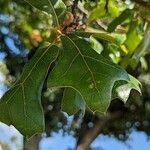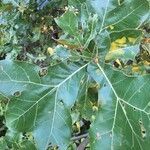Trees , deciduous, to 15 m. Bark almost black, with irregular or rectangular blocks, inner bark orangish. Twigs ashy brown, (1-)2-4(-5) mm diam., pubescent to tomentose. Terminal buds conic or narrowly ovoid-ellipsoid, 5-10 mm, noticeably 5-angled in cross section, tawny pubescent. Leaves: petiole 5-20 mm, densely to sparsely pubescent. Leaf blade obovate to obtrullate, (50-)70-200 × (40-)70-200 mm, base rounded or cordate, blade not decurrent, margins with 3-5 shallow, often very broad lobes and 3-10 awns, apex acute to obtuse, rarely rounded; surfaces abaxially scurfy or with scattered pubescence, adaxially glossy, glabrous, secondary veins raised on both surfaces. Acorns biennial; cup turbinate, 6-10 mm high × 13-18 mm wide, covering 1/3 nut, outer surface puberulent, inner surface pubescent, scale tips loose, especially at margin of cup, acute or acuminate; nut broadly ovoid or ellipsoid, 12-20 × 10-18 mm, often striate, glabrate, scar diam. 5-8 mm. 2 n = 12. [R. C. Friesner 1930. J. W. Duffield (1940) suggested that Friesner was counting bivalents; if so, then 2 n = 24, consistent with all other reports for Quercus .]
More
A deciduous tree. It grows 12-15 m high. It spreads 10 m wide. It is a broadly spreading oak tree. The bark is blackish and cracks into small square plates. The leaves are triangle shaped and 25 cm long by about 20 cm across. They taper to the base. There are usually 3 lobes at the top. They are dark green and glossy above and paler underneath. The male and females flowers are separate but on the same plant. The male flowers are easier to see and are yellow-green and droop. The fruit is an acorn about 2 cm long. About half of the nut is enclosed in a cup.
Found on poor sites with dry, sandy or clay soils, often on barrens, open fields and dry ridges; becoming dominant in savannahs and transitional areas between forests and grasslands; at elevations up to 900 metres.
More
It is a temperate plant. It is native to the eastern United States. It grows on poor, often sandy soil. It grows up to 900 m altitude in SE regions of the USA. It suits hardiness zones 5-9. Arboretum Tasmania.




